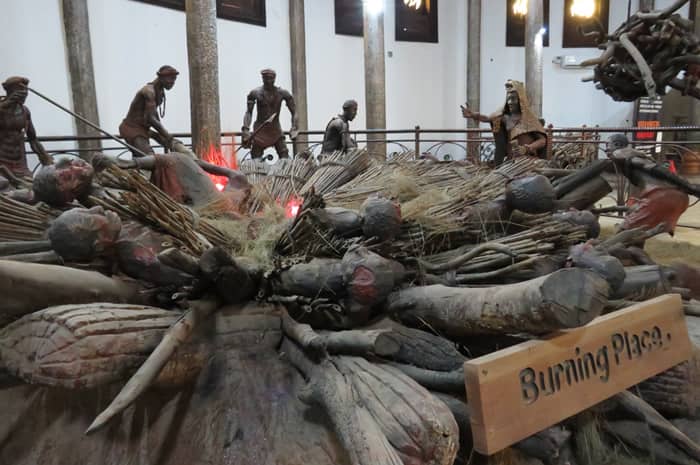By Spy Uganda
The Uganda Martyrs are a group of 22 Catholic and 23 Anglican converts to Christianity in the historical kingdom of Buganda, now part of Uganda, who were executed between 31 January 1885 and 27 January 1887.

These martyrs who are celebrated every 3rd June were killed on orders of Mwanga II, the Kabaka (King) of Buganda then. The episode occurred against the backdrop of the “Scramble for Africa” – the invasion, occupation, division, colonization and annexation of African territory by European powers.
History You Must Know

Publication in Britain of an 1875 letter purporting to be an invitation from the king of Buganda, Muteesa I, to send missionaries, resulted in the arrival of Alexander Mackay of the Anglican Church Missionary Society to Buganda in 1877. A group of French Catholic White Fathers, led by Père Simon Lourdel (Fr. Mapera) appeared two years later. Arab traders from Zanzibar had introduced Islam into the kingdom. This effectively led to a three-way religious struggle for political influence at the Buganda royal court. By the mid-1880s, many had been converted by each of the three groups, and some of the converts held important posts at the king’s court. Muteesa himself sympathized with Islam, but many prominent chiefs had become Christians.
Kabaka Mwanga II succeeded to the throne in 1884. He was concerned at the growing influence of Christianity and the rise of a new class of officials, distinct from the traditional territorial chiefs, who were educated, had a religious orientation, and wished to reform Ganda society. The German annexation of what is now Tanzania sparked further alarm. A year after becoming king he ordered the execution of Yusufu Rugarama, Makko Kakumba, and Nuwa/Noah Serwanga, who had converted to Christianity. Encouraged by his prime minister, on 29 October 1885 he had the incoming Anglican bishop James Hannington assassinated on the eastern border of his kingdom. This may have been deliberately intended to send a message to the British that he did not wish for them to make inroads in Uganda. It is also alleged that the murder of Bishop James Hannington was due to a myth at the time that enemies that would destroy the Kingdom would come from the East. The direction which the Bishop was coming from. Thus the Kabaka had chief Luba of Busoga Chiefdom in the East execute the Bishop. Mwanga did, however, subsequently appoint several Christians to important military positions.

Executions & What Angered Kabaka In 1885–86
In 1886 Mwanga ordered the executions of many members of the royal court for refusing to yield to his religious demands, which he saw as insubordination. Heike Behrend says they were both Christian and Muslim converts; other sources speak only of Anglican and Catholic victims, and mention the killing of Muslims as having occurred ten years earlier at the hands of Mwanga’s father Muteesa. Joseph Mukasa, a convert to Christianity who had deplored the assassination of Hannington, and had tried to protect the court pages, was the first to be executed on 15 November 1885: this was at the instigation of the Katikkiro (prime minister) Mukasa, whose successor Joseph Mukasa was tipped to become king. Then, between 25 May and 3 June 1886, a wider series of executions were carried out. Mwanga instructed the killing of all the young men who disobeyed him – partly to satisfy the demands of the older chiefs. Twenty-two of the men, who had converted to Catholicism, were burned alive at Namugongo in 1886.
“The reasons behind the persecution are still heavily debated”, Behrend states. Political factors certainly played a part. Those killed included minor chiefs, some of whom, such as Joseph Mukasa, were “the victims of particular grudges by their seniors … jealous that these up and coming young men would soon be ousting them from power”. Ward has argued that the motivation was the perception that “these Christians were rebels against the Kabaka, unwitting tools of foreign imperialism”.
A witness to the event, the French missionary priest Lourdel, considered that the principal cause was Mwanga’s feeling of being despised by the literate Christians who claimed a superior knowledge of religion. Lourdel gave as a secondary cause of Mwanga’s action the refusal of the pages to meet traditional royal demands of sexual submission. The king, who by tradition had the power of life and death over his subjects, was angered by this refusal to obey his wishes to have sex with him.
Marie de Kiewet-Hemphill concludes that the immediate pretext, if not the whole cause, was therefore the refusal of the pages to offer themselves to Mwanga Roland Oliver rejects resentment against Christianity as a sufficient reason, since it does not explain why Mwanga took action against these young men and not against prominent chiefs and women among the converts. Sylvia Antonia Nannyonga-Tamusuza draws attention to the same point. J. P. Thoonen in his book on the question agrees with Kiewet-Hemphill’s analysis, while recognizing the existence of other political factors. Particularly as some of those that renounced their faith were spared death.”
In the week leading to the executions, the Christian Matthias Gayinga rejected the homosexual demands of Mwanga’s close friend, the Muslim Lutaya, to whom the king had sent him for that purpose. For this he was severely punished, though not killed. His stance was described as a “splendid refusal” by the English missionary A. P. Ashe, who later said it set the spark for later events. His action was followed by the refusal of another convert, Anatole Kirrigwajjo, to accept nomination to a high post “which he could only exercise at the peril of his soul”.
While many of the Christian pages often arranged to be missing when Mwanga demanded them, or refused his homosexual solicitation outright, one page Muwafi did comply. Mwanga is said to have caught another page teaching Christianity to Muwafi. Mwanga saw this as an attempt “to rob him of his favourite and so far always compliant toy, by teaching him the religion which made them prefer death to submission”. Mwanga summoned the pages and asked those who prayed to stand to one side. These, most of whom were between 15 and 30 years old, were then taken on a long journey to execution by being burnt alive.
List of the Catholic martyrs
Achilleus Kewanuka (d. 3 June 1886)
Adolphus Ludigo-Mukasa (d. 3 June 1886)
Ambrosius Kibuuka (d. 3 June 1886)
Anatoli Kiriggwajjo (d. 3 June 1886)
Andrew Kaggwa (d. 26 May 1886)
Antanansio Bazzekuketta (d. 27 May 1886)
Bruno Sserunkuuma (d. 3 June 1886)
Charles Lwanga (d. 3 June 1886)
Denis Ssebuggwawo Wasswa (d. 25 May 1886)
Gonzaga Gonza (d. 27 May 1886)
Gyavira Musoke (d. 3 June 1886)
James Buuzaabalyaawo (d. 3 June 1886)
John Maria Muzeeyi (d. 27 January 1887)
Joseph Mukasa (d. 15 November 1885)
Kizito (d. 3 June 1886)
Lukka Baanabakintu (d. 3 June 1886)
Matiya Mulumba (d. 30 May 1886)
Mbaga Tuzinde (d. 3 June 1886)
Mugagga Lubowa (d. 3 June 1886)
Mukasa Kiriwawanvu (d. 3 June 1886)
Nowa Mawaggali (d. 31 May 1886)
Ponsiano Ngondwe (d. 26 May 1886)
List of the Anglican Protestant martyrs
Makko Kakumba
Yusuf Lugalama
Nuwa Sserwanga
Mukasa Musa
Eriya Mbwa
Muddu Aguma
Daudi Muwanga
Muwanga
Kayizzi Kibuuka
Mayanja Kitogo
Noah Walukaga
Alexander Kdoko
Fredrick Kizza
Robert Munyangabyanjo
Daniel Nakabandwa
Kiwanuka Gyaza
Mukasa Lwakisiga
Lwanga
Mubi
Wasswa
Kwabafu
Kifamunnyanja
Muwanga Njigiya.








